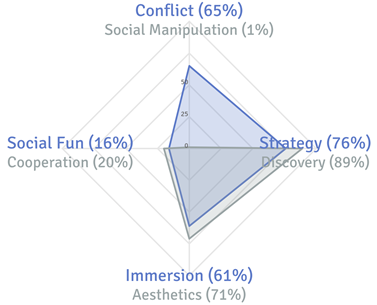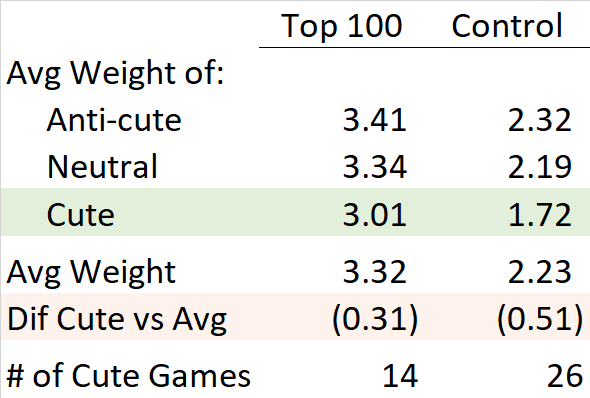Cute vs Complex Games – When & Why We Subvert Expectations
Jasper Burch from Pine Island Games has an amazing blog with all sorts of fantastic game design advice. I love his writing style and the depth he goes into on some pretty interesting topics. So, this week, I asked him to write a guest blog about cute vs complex games and to talk about whether these concepts are mutually exclusive or if they can work together in a single game. Enjoy!
“A mismatch (say, silly theme and fairly complex mechanics) is problematic.”
“It doesn’t need to match. But, from experience with my game, lots of adults discount it based on the cute factor, because they assume it’s for kids only.”
These are quotes from recent conversations I’ve had with designers and share a sentiment that I’ve seen many times. The idea is that cute illustration and subject matter communicates to consumers that a game is lighter weight. And, as a corollary medium to heavier weight games should avoid “cute”, or risk alienating consumers.
I disagree. And at the end of this article, I’ll provide some reasons to make a cute & complex game. But, before we get into all of that, I think we need a little context.
Psychographic Clustering
Psychographics or gamer motivation profiles describe the aspects of gaming that resonate with different players. Some players value immersion, some love confrontation, some like variance, and others want deep deterministic strategy.
What is fascinating is that player motivations have strong correlations. That is, player motivations tend to cluster into gamer archetypes.
Wizards of the Coast has famously named their interpretations of these archetypes:
- Timmy/Tammy – Social gamers
- Johnny/Jenny – Exploratory & creative gamers
- Spike – Competitive gamers
- Vorthos – Immersive gamers
One of my favorite sources for understanding gamer psychographics is the Quantic Foundry – which is a consulting firm in the tabletop and video game space. They have a survey that maps your psychographic profile – and goes so far as to recommend games that you may like based on those preferences.
As an example, here is my psychographic profile:

I value strategic depth, exploring mechanics, conflict, and immersion. I value social fun, and cooperation lower than most gamers, and dislike social manipulation (diplomacy type games). There is no right or wrong psychographic profile – but gamer motivations tend to correlate.
In Quantic Foundry’s survey, gamers who are high in Strategy tend to also be high in Discovery. The same goes for Immersion & Aesthetics, Conflict & Social Manipulation, and Social Fun & Cooperative Play.
These couplings aren’t written in stone, but they are covariates. By a similar logic, someone high in Strategy is less likely to have a high preference for Social Fun. Someone who loves take-that mechanics (Conflict) is less likely to also value Aesthetics and Immersion.
It isn’t that those pairings can’t go together, it’s that they are less likely to.
I wanted to contextualize psychographics in order to make two overarching points:
- Games that lean heavily into one motivation will sometimes be naturally diametric to other elements – for instance, a game that is deep in crunchy strategy is less likely to have an emphasis on social fun. Similarly, aesthetics will be less important to certain types of games – and I believe that we’ve seen a historical trend of Euros intentionally de-emphasizing their illustration (although this trend seems to be shifting).
- There will always be gamers whose psychographic profiles break the correlations – players who love conflict in a beautifully immersive world, or crunchy strategy gamers who want to laugh with their friends as they struggle through a puzzle. Similarly, there is plenty of room for games to cater to the less usual pairings: such as escape rooms in a box being social, coop and crunchy, or something like Codenames which is heavy on strategy, and a raucous social game.
For further reading on psychographics and gamer profiles, check out my article: Do Demographics & Psychographics Matter in Design?
It’s For the Children
There are obvious thematic and stylistic constraints that apply to children’s games. You can’t have gore, scary monsters, anything with a sexual connotation. And beyond that, certain art styles should resonate with children and families – cartoons, bright and soft colors, things that are cute.
This means that we would expect to see some over-representation of cute games targeted at children and families, and so definitionally lighter weight.
It’s likely that some consumers therefore associate cute with lightweight, and that they could have their expectations subverted. This might lead to feel bad moments (a family buying a game that is unplayable for their kids), but the subversion could also excite and engage a different consumer.
The Exceptions
When I started having these conversations, a few games immediately came to mind:
- Root: Holding the 26th spot on Board Game Geek’s top 100, Root is full of forest critters, and features an art style that is reminiscent of 70s children’s books and movies. It’s also pretty heavyweight at 3.72 (out of 5) on BGG.
- Everdell: Again, with the forest critters, Everdell has adorable artwork that features little buildings in a giant tree. The game sits solidly in the mid-weight camp with a 2.82 rating.
- Spirit Island: With cartoon spirits and bright colors, Spirit Island is the heaviest (4.03), and highest ranked (11th on BGG) game on this shortlist.
- Bunny Kingdom: Bunny Kingdom by Richard Garfield features, well bunny knights, bunny castles, and a cloud kingdom expansion. The game has a slightly lower complexity rating than the others (at 2.28), but to me plays crunchier than that rating implies.
The fact that some (very successful) games are both cute and complex doesn’t mean that the combination is a good idea for most games, or even that a cute & complex mismatch will on average help or hurt a game.
What it does tell us is that there is a subset of gamers who enjoy cute games with complex play. We can see a similar dynamic with Magic: The Gathering, with Wizards of the Coast publishing supplemental themed kittycat cards, and squirrels, and players altering their cards to have cute subject matter.
By the Numbers
I had my fiancé and business partner (Chelsea) rank all the games in the BGG top 100 as: anti-cute (1), neutral-cute (2), or cute (3). I then had her rate a control group of 100 games using the BGG random game function. The one constraint was that games in the control group needed at least 50 ratings.
Here are the results:

For those interested, the raw data is here. (Chelsea didn’t know the purpose of the ratings, as I didn’t want her biased).
A few things jump out to me from the numbers.
- The average weight of games in the top 100 is substantially higher than the average weight in the control group.
- Both the top 100 and control groups have some correlation with weight and complexity, but that correlation is stronger in the control group.
- The control group has a higher concentration of cute games than the top 100 group.
What’s Going On?
While the methodology isn’t strictly scientific, I think there are a number of interesting takeaways and implications.
First, it’s worth noting that BGG raters prefer heavier games, and that weight rating doesn’t necessarily correlate with success. In fact, the most successful games are gateway level difficulty, or lighter (just check out Amazon’s list of best sellers).
Second, the control group (which is on average less successful than the top 100) has a higher concentration of cute games. While part of this could be publishers trying to align the illustration style with the game weight, I suspect that a big driving factor is the cost of illustration and budget constraints.
Fully rendered illustration is more expensive than cell-shaded or cartoon style illustration. Cute cartoon style artwork is also more forgiving of lower skill level work (which should be more affordable). The cute games in the top 100 have high quality (likely high cost) illustrations. The choice of a cute theme is therefore stylistic, and not budgetary.
Lastly, the average weight of cute games in the top 100 is substantially higher than the average weight of overall games. That is, they are mechanically heavier. While I haven’t done the analysis, I wouldn’t be surprised if among cute games, heavier weight is correlated with a better rating on BGG. By breaking the mold and subverting cute vs complex expectations, those games are more likely to be successful.
Reasons to Make a Heavy & Cute Game
At the end of the day, I think it’s easy for us as creators to create and lean on heuristics [rules of thumb, or mental shortcuts that generally hold as true]. And while they can hold in a lot of cases, we need to be critical about our artistic and stylistic choices. I don’t think that every complex game should have cute illustrations (most probably shouldn’t), but the pairing can be done successfully.
So, when should a heavy game have cute a cute art style?
- When it makes the game more approachable: I believe the theme and illustrative style of a game like Wingspan makes it more approachable and broadens the appeal. The game isn’t insanely heavy (it weighs in at 2.44), but it is solidly mid-weight.
- Because subverting expectations is fun: People like being surprised and they like subverted expectations. It’s the trope of a cute cuddly creature having a mouth full of razor-sharp teeth. Intentionally subverting expectations can be a powerful tool to engage people with your overall design and get them talking about your game.
- When it is in line with your overall vision: My most important takeaway is that we as designers and publishers need to have an overall vision for what we are creating. That vision can be cute and cuddly, it can be scary, gory, stark, or minimalist. But, whatever it is, it needs to resonate with us. Don’t be afraid to create something new, and wonderful, and unexpected, but make sure you are creating it with a purpose.
I want to thank Joe for letting me take over his blog for a day. If you like this kind of meandering analysis and the occasional deep dive, then I invite you to check out my twice-weekly blog. You can also hop on our mailing list and hang out in the Facebook group for our next game Nut Hunt.
(Joe’s comment: I highly recommend checking out Jasper’s site. It is filled with a wealth of great articles)
What games subverted your expectations in a delightful way?

6 comments
Brian Henk
I love how data-driven this is. I’ve been struggling with this on one of our upcoming games so it, at the very least, helps me feel better about the mismatch we have between cuteness and complexity. Thanks guys!
Joe Slack
Thanks, Brian! Jasper is a great writer and he shares all sorts of helpful articles on his site. Make sure to check it out!
Lawrence Davies
fantastic blog. Required reading if you wish to have a PhD in Board Games Design
Joe Slack
Absolutely, Lawrence! I love how in-depth Jasper looks at topics like this.
Tony Ripley
Great information and research. Thanks for sharing this. I have to be aware of this from not falling into the trap the other way; “if my game works this way then I need to themed it and provide art that is adult and strict” or “Kid friendly”.
Important to step back and double check again – what is the game I want to make? Then see if I need to help customers understand why it might look like a rough game, but is simple.
Joe Slack
Great insights, Tony!